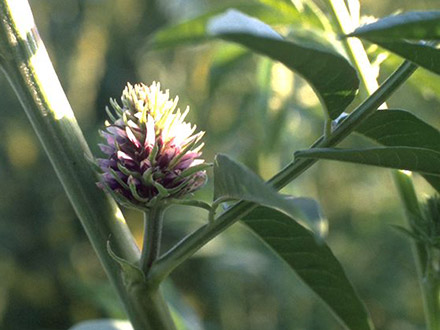Botanical name
Glycyrrhiza glabra L.
Family
Fabaceae
Common name
Licorice, Liquorice, Sweetwood
Information about the plant
Liquorice, with its different varieties, populates a large area from southeastern Europe to Asia, Ukraine, Central Russia, southern Siberia, Afghanistan, and western China.
The plant is cultivated in warm temperate to subtropical countries on all continents. The long-lived bush grows over 1 m high and is anchored with a long, thick taproot and thick lateral roots in the soil. Each year, strong stems with odd-pinnate leaves (3 to 7 pairs each) grow from a very woody rhizome (underground stem). The individual leaflets are ovate and abaxial, hairy on the underside, otherwise glabrous (Latin "glaber", "glabra" = bald). Several small pale lilac-coloured butterfly flowers grow close together in 10 to 15 cm long racemes in the leaf axils. The fruits are 1.5 to 2.5 cm long pods with kidney-shaped seeds.
The name genus Glycyrrhiza, from the Greek "glykys" = sweet and 'rhiza' = root, refers to the very sweet-tasting root caused by the glycyrrhizin contained in the root, a triterpenoid that has approximately 50 times the sweetening power of cane sugar (sucrose). A "licorice juice" (liquiritiae succus) is extracted from the root, which is incorporated into the world's most popular liquorice sweets. To do this, the fresh roots are crushed and boiled with water for many hours. The extracted juice is then very slowly thickened into a viscous consistency. The typical liquorice flavour forms during this process. The viscous extract is incorporated at a maximum of 5% to 50% into liquorice products. These are made from sugar, flour, starch and/or gelatin, as well as fragrances and flavorings. The Federal Association of the Confectionery Industry specifies a maximum level of 200 mg of glycyrrhizin per 100 g of liquorice products. Products with a higher content must be labeled as "Strong licorice", indicating a high intake (see side effects). The first licorice in the typical snail shape is said to have been produced in Germany in 1925.
Medicinally used parts of plants (herbal drug)
The dried, peeled or unpeeled roots with their runners (Liquiritiae radix - licorice root) are used. The commercially available drug comes from cultivations in China, Russia, and Turkey, as well as from Italy, Bulgaria, and Spain.
Constituents of the herbal drug
Licorice root contains triterpene saponins (mainly glycyrrhizin), flavonoids, isoflavones, and polysaccharides.
Quality of the drug
The quality of the following drugs or drug preparations is specified in the European Pharmacopoeia (Ph. Eur.):
- Licorice root (Liquiritiae radix)
- Licorice root dry extract as a flavoring agent (Liquiritiae extractum siccum ad saporandum)
Medical applications
Recognised medical use
The HMPC has classified licorice root as a traditional herbal medicinal product (see "Traditional use").
ESCOP: As adjuvant therapy for gastric and duodenal ulcers, and gastritis; as an expectorant for coughs and bronchial catarrh.
Traditional use
Licorice root has been classified by the HMPC as a traditional herbal medicinal product (Article 16a of Directive 2001/83/EC). Based upon long-standing use, licorice root can be used to relieve dyspeptic complaints and heartburn and as an expectorant for coughs associated with colds.
Herbal drug preparations in finished dosage forms
- Cut liquorice root to prepare tea
- Dried extract in soluble instant teas and chewable tablets
- Alcoholic extracts in drops
Dosage
Prepared drugs: see patient information leaflet.
Tea: take 1 cup of licorice tea 3 to 4 times a day, daily dose: 5 to 15 g of the drug equivalent to 200 mg to 600 mg of glycyrrhizin.
Preparation of a tea
Mix 1 to 1.5g of finely chopped or coarsely powdered liquorice root with 150 ml of cold water, boil, then remove from the hob and strain after 10 to 15 minutes. The infusion can also be made with boiling water.
Notes
Licorice root should not be taken by people who have cholestatic liver diseases, liver cirrhosis, high blood pressure, potassium deficiency, or severe renal insufficiency. During pregnancy, licorice root and licorice should be avoided.
The use of licorice root in children and adolescents under the age of 18 is not recommended due to a lack of evidence.
Patients with high blood pressure, kidney disease, liver or cardiovascular disease, and potassium deficiency should not take licorice root as they are more sensitive to the side effects of licorice root.
Side effects
With prolonged use and higher doses, mineralocorticoid effects, such as sodium and water retention, can cause potassium loss with high blood pressure, edema (accumulation of fluid in tissues) and, in rare cases, myoglobinuria (protein from muscle tissue in the urine).
Interactions
Potassium deficiency caused by other drugs (e.g. thiazide and loop diuretics) can increase; with reduced potassium levels, the sensitivity to cardiac glycosides (digitalis) increases. Therefore, licorice root should not be taken at the same time as these medications.
References
Herbal drug monographs
HMPC (2012), ESCOP (2003), WHO (Vol. 1, NIS)
Further literature
Commentary on the European Pharmacopoeia (licorice root, No. 0277; licorice root extract as a flavor enhancer, No. 2378


